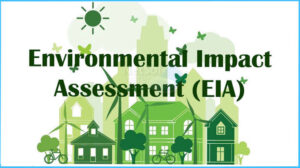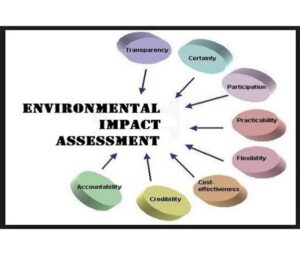Back to: Environmental Biology 400 Level
Welcome to class!
You know that excitement when a new road, factory, or housing estate is being built in your area? While development is great, have you ever wondered how those projects affect the land, water, air, and people living nearby? That’s where Environmental Impact Assessment (EIA) comes in. It’s one of the most important tools used to check whether a development project will harm or benefit the environment—and how to reduce the harm before it happens.
Introduction To Environmental Impact Assessment
What is Environmental Impact Assessment?
Environmental Impact Assessment (EIA) is a formal process used to identify, predict, and evaluate the potential environmental effects of a proposed project before decisions are made. It helps project developers, government, and communities understand the likely consequences of development activities and how to manage them responsibly.

EIA ensures that decisions are made with full knowledge of the environmental, social, and health implications of a project.
Key Objectives of EIA
To predict environmental impacts before they occur
To suggest ways to avoid or reduce negative impacts
To encourage sustainable project planning and decision-making
To promote public participation and transparency
To help protect human health and the environment
When is EIA Required in Nigeria?
In Nigeria, EIA is required for any major project likely to affect the environment. This includes:
Oil and gas exploration
Highway construction
Dams and irrigation projects
Mining and quarrying
Large-scale agricultural developments

Urban and industrial developments
The process is governed by the Environmental Impact Assessment Act CAP E12 LFN 2004, overseen by the Federal Ministry of Environment.
Basic Steps in the EIA Process
Screening – To decide if EIA is needed for a project
Scoping – To determine which impacts should be studied
Impact Analysis – To predict environmental, social, and health impacts
Mitigation – To suggest ways to reduce or avoid negative effects
Reporting – A comprehensive EIA report is submitted
Review and Decision – Authorities assess the report and approve or reject the project
Monitoring – Ongoing checks to ensure that the project follows the approved guidelines
Example in Nigeria
When Dangote Refinery was being planned in Lagos, an EIA was carried out to assess how it might affect nearby communities, water sources, air quality, and wildlife. The EIA helped identify risks like emissions and traffic congestion and suggested ways to reduce them.
Importance of Public Participation

Involving local people in the EIA process helps identify issues that outsiders may overlook. It ensures fairness and gives a voice to those directly affected. Town hall meetings, public notices, and community surveys are used to gather public input.
Summary
- EIA is a process used to assess the environmental effects of development projects before they begin.
- It helps prevent environmental harm and promotes sustainable development.
- Key steps include screening, scoping, analysis, mitigation, reporting, and monitoring.
- EIA is required by law in Nigeria for major projects and is regulated by the Federal Ministry of Environment.
- Public participation ensures the process is inclusive and transparent.
Evaluation
- What does EIA stand for and why is it important?
- List three types of projects that require EIA in Nigeria.
- Mention four key steps in the EIA process.
- Why is public involvement important in EIA?
- Which Nigerian law governs the EIA process?
You’ve just taken a major step towards understanding one of the most powerful tools in environmental protection. Remember, as a future environmental expert, your voice matters in shaping a safer, healthier Nigeria. Keep learning, keep leading—and Afrilearn is always proud to walk this journey with you!
